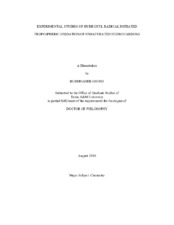| dc.description.abstract | The tropospheric oxidation of unsaturated hydrocarbons is a central issue in atmospheric chemistry. These hydrocarbons are emitted into the atmosphere from both natural and anthropogenic sources, and their atmospheric oxidation leads to different atmospheric pollutants, including ground level ozone, photochemical smog and secondary organic aerosols. Isoprene and 1,3-butadiene represent a biogenic and an anthropogenic hydrocarbon, respectively, which primarily undergo electrophilic addition of OH radical, followed by chain propagating radical reactions. Their oxidation is the major source for ground level ozone formation in both rural and urban area and understanding their chemistry is essential for regional air quality modeling.
Until recently, most of the studies of isoprene chemistry have been non-isomer specific, reflecting the reactivity of combined pathways and therefore were insensitive to specific details of the isomeric pathways. An isomeric selective approach to studying unsaturated hydrocarbon oxidation is described in this dissertation. A synthesized precursor, whose photolysis can provide a route to the formation of energy selected single isomer in the isoprene oxidation pathway, enables the study of important channels that are difficult to unravel in non isomer specific experiments. The major addition channel in OH isoprene oxidation has been studied following the isomeric selective approach and using Laser Photolysis-Laser Induced Fluorescence (LP-LIF) as the primary experimental
technique. The study reveals important information about the oxidative chemistry of the δ-peroxy radicals, accounting for about 20 percent of missing carbon balance in isoprene oxidation, and isomeric specific rate constants.
A similar approach was applied to study the oxidation of 1,3-butadiene, and the photolytic precursor for the dominant hydroxy alkyl isomer in the OH initiated oxidation of 1,3-butadiene was synthesized. The subsequent experiments and analysis revealed detailed information about the oxidative chemistry accounting for approximately 26 percent of the missing chemistry.
Finally, non isomeric selective OH cycling experiments were carried out on the1,3-butadiene system. By analyzing the OH cycling data with the combined information obtained from the isomeric specific studies of the two isomeric channels of 1,3-butadiene oxidation, the relative branching between the two isomeric channels of OH-1,3-butadiene oxidation was determined. | en |


